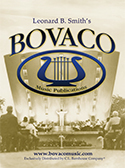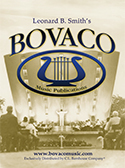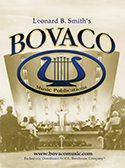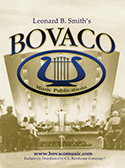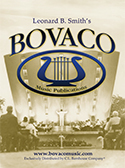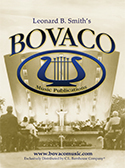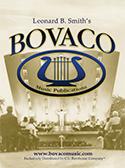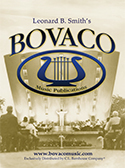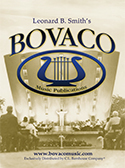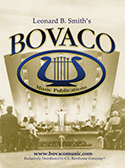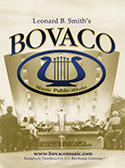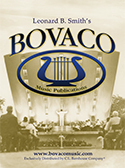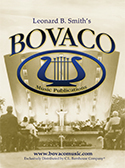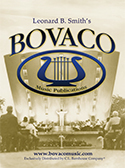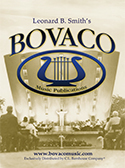Leonard B. Smith

Poughkeepsie, NY native Leonard B. Smith (b. 1915) began the study of cornet at the age of 8. Smith progressed quite rapidly; and after 3 years of study be began lessons with Ernest S. Williams, who maintained a studio in New York City. Over the ten-year period that Smith studied with Williams, he performed quite extensively with several fine ensembles. Smith won a scholarship to the New York Military Academy, in whose band he played; he also became a noted performer with the Georges Barrere “Little Symphony,” as it was known. He attended summer band camp at the Ernest S. Williams School of Music in Saugerties, NY, where he expanded his musical abilities into the areas of composition, arranging, and conducting.
In 1936, when legendary cornetist Del Staigers vacated his position as cornet soloist of the famed Goldman Band, Williams contacted Edwin Franko Goldman and recommended his star pupil, Leonard B. Smith. Performing before huge audiences in both New York’s Central Park and Brooklyn’s Prospect Park, Smith became a star attraction.
As the Goldman Band’s season encompassed only the summer months, Smith auditioned for the Detroit Symphony, winning the principal trumpet position. This opportunity afforded Smith one of the finest playing engagements available. At the time the Detroit Symphony performed 39 weeks per season on radio broadcasts of the Ford Sunday Evening Hour. During this time Smith played under and became acquainted with many of the leading conductors of the day, including Eugene Ormandy and Fritz Reiner. He continued to play in the summers with Goldman and in winters with the Symphony through 1941. Also in those golden days of radio, it was the trumpeting of Leonard B. Smith that opened weekly radio broadcasts of the popular “Lone Ranger” broadcasts for many years.
Upon the start of the Second World War, Smith enlisted in the United States Navy, assigned first with the Philadelphia Navy Yard Band and soon thereafter, with the U. S. Navy Band in Washington, D.C. He continued to perform solos on many Navy Band broadcasts and concerts. At the conclusion of World War II, Smith discovered that the war had disrupted his playing career. The Detroit Symphony had replaced the first trumpet, and Goldman had secured a new soloist. This provided Smith with the opportunity to form his own concert band in Detroit. This new group gave its first concert in 1946. Known variously through the years as the Leonard Smith Band and the Belle Isle Concert Band, it is best remembered today as the Detroit Concert Band. The band recorded 31 LP albums, including the complete published marches of John Philip Sousa, and became the pre-eminent civilian concert band of its time.
For the next thirty-five years, Smith’s musical reputation grew to legendary and unmatched proportions. He performed cornet solos and trios with his own band, and became a frequent clinician and guest soloist/conductor with hundreds of school, college and community bands. He composed dozens of brass solos and ensembles and served as a consultant for a popular band method book. The Reynolds Co. designed and manufactured a Leonard Smith model cornet, and throughout this era he was known as “America’s Premier Cornet Soloist.”
During his long and distinguished performing career, Smith reached many milestones. He recorded professionally as a cornet soloist for 45 years, and appeared in public as soloist on literally thousands of occasions. He is generally regarded as one of the most consistent and accomplished cornet and trumpet artists of his day, and the great champion of the classic concert band in the second half of the twentieth century.
Leonard passed away on July 23, 2002, in Scottsdale, Arizona.
Publications by Leonard B. Smith
-
On Conducting The Professional Concert Band
L. B. Smith
Text Method
079-6200-00More Info079-6200-00 -
BOV-S0650-00
-
Advocate-Messenger
L. B. Smith
Grade: 3.5
BOV-S0797-00More InfoBOV-S0797-00 -
Afton Water
Hume/arr. L. B. Smith
Grade: 3
BOV-S0576-00More InfoBOV-S0576-00 -
Ald Old Song Re-sung
Griffes/arr. L. B. Smith
Grade: 3
BOV-S2187-00More InfoBOV-S2187-00 -
Allerseelen
R. Strauss/arr. L. B. Smith
Grade: 3
BOV-S0618-00More InfoBOV-S0618-00 -
America; Star Spangled Banner
Carey/arr. L. B. Smith
Grade: 3
BOV-S2304-00More InfoBOV-S2304-00 -
America; Star Spangled Banner
Carey/arr. L. B. Smith; Carey/arr. L. B. Smith
Grade: 3
BOV-S2305-00More InfoBOV-S2305-00 -
America; The Star Spangled Banner
Carey/arr. L. B. Smith; J. S. Smith/arr. L. B. Smith
Grade: 3.5
BOV-S0556-00More InfoBOV-S0556-00 -
American Champion
L. B. Smith
Full set
Grade: 3.5
BOV-S3680-00More InfoBOV-S3680-00 -
An die Musik
Schubert/arr. L. B. Smith
Grade: 4
BOV-S0653-00More InfoBOV-S0653-00 -
Annie Laurie
arr. L. B. Smith
Grade: 4.5
BOV-S0638-00More InfoBOV-S0638-00 -
BOV-S0612-00
-
Avant de quitter
Gounod/arr. L. B. Smith
Grade: 3.5
BOV-S0536-00More InfoBOV-S0536-00 -
BOV-S0506-00
-
The Baton Twirler
L. B. Smith
Full set
Grade: 3.5
BOV-S3681-00More InfoBOV-S3681-00 -
Believe Me, If All Those Endearing Young Charms
T. Moore/arr. L. B. Smith
Grade: 3.5
BOV-S0581-00More InfoBOV-S0581-00 -
Belle Isle
L. B. Smith
Grade: 3.5
BOV-S3682-00More InfoBOV-S3682-00 -
Bendemeer’s Stream
Gatty/arr. L. B. Smith
Grade: 3.5
BOV-S0624-00More InfoBOV-S0624-00 -
The Blue Flame
L. B. Smith
Grade: 3.5
BOV-S0712-00More InfoBOV-S0712-00 -
BOV-S0641-00
-
BOV-S0633-00
-
Carnival of Carnivals
L. B. Smith
Grade: 3.5
BOV-S0799-00More InfoBOV-S0799-00 -
Caro Mio Ben
Giordani/arr. Smith
Grade: 3
BOV-S0522-00More InfoBOV-S0522-00 -
Celeste Aida
Verdi/arr. L. B. Smith
Grade: 4
BOV-S0528-00More InfoBOV-S0528-00


